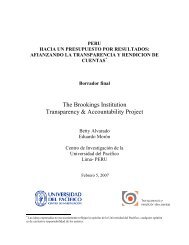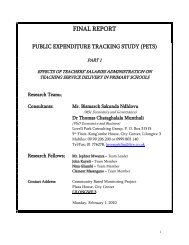Provider Purchasing and Contracting for Health Services_The Case
Provider Purchasing and Contracting for Health Services_The Case
Provider Purchasing and Contracting for Health Services_The Case
Create successful ePaper yourself
Turn your PDF publications into a flip-book with our unique Google optimized e-Paper software.
where funders of care tend to ab<strong>and</strong>on their passive role <strong>and</strong> aggressively negotiate <strong>for</strong> costeffective<br />
care (Mwansa et al. 2002). Moreover, the choice of the purchasing arrangement is<br />
critical <strong>for</strong> the available alternatives regarding contracting <strong>and</strong> payment mechanisms.<br />
<strong>Provider</strong>s may have to compete <strong>for</strong> contracts, though the type of competition may differ<br />
depending on the contracting model.<br />
According to Mwansa <strong>and</strong> colleagues (2002), two competition models with entirely different<br />
effects on costs, efficiency, <strong>and</strong> consumer choice can be identified. <strong>The</strong>se are, first, the<br />
models in which providers compete within the market. <strong>The</strong> example provided is the<br />
traditional American system in which hospitals compete <strong>for</strong> patients within an open fee-<strong>for</strong>service<br />
payment from insurance companies. <strong>The</strong> quality of service, determined by the<br />
doctor’s <strong>and</strong> patient’s perceptions, is the key competitive factor resulting in an increase in<br />
expenditures. Moreover, surveys indicate that expenditures in areas with many providers, that<br />
is, a more competitive area, are higher compared with areas with few providers <strong>and</strong> less<br />
competition. In the second model, constable purchasing is employed. <strong>Provider</strong>s compete <strong>for</strong> a<br />
market that mostly characterizes contracting-out. <strong>Provider</strong>s bid <strong>for</strong> the service <strong>and</strong> the most<br />
attractive service package is given a temporary monopoly on that service <strong>for</strong> the contract<br />
period. In this model, research findings show that purchasers can save on expense, although<br />
consumer choice is constrained compared with the first model.<br />
<strong>The</strong> level of competition in the health system affects the conditions <strong>for</strong> pricing the service. In<br />
a competitive market, in which payment is made by a third party or a provider is a monopoly,<br />
payment to the providers will have to be set according to some administrative rules that could<br />
include taking the average cost <strong>for</strong> different services as the administrative price or using<br />
actual costs from efficient providers. <strong>The</strong> use of actual costs could place pressure on<br />
inefficient providers to improve their service delivery. If competition <strong>for</strong> the market is used,<br />
providers bid to supply the service. <strong>The</strong> purchaser’s role is to choose a supplier that optimizes<br />
his resource use by selecting the best offer from the cost-benefit perspective (Mwansa et al.<br />
2002. If alternative health services providers are not available, competition in smaller cities<br />
may be limited or may not even exist. In such cases, the criteria of per<strong>for</strong>mance-based<br />
payment <strong>and</strong> incentives <strong>for</strong> efficiency could be satisfied to a comparatively high degree by a<br />
system of administered prices (Zweifel <strong>and</strong> Breyer, 1997). In case of Zambia, contracting-in<br />
requires payments set through administrative rules.<br />
In the Zambian health sector, the Ministry of <strong>Health</strong>’s budget is under the Ministry of<br />
Finance <strong>and</strong> National Planning. <strong>The</strong> contracting of health services is negotiated <strong>and</strong><br />
administered by the Ministry of <strong>Health</strong> thus acting as the principal. <strong>The</strong> providers, such as<br />
tertiary <strong>and</strong> district hospitals, act as agents that allocate the resources to functions in the<br />
health care delivery chain. Controversies in principal-agent relationships pertain mainly to the<br />
different objectives that each party may have. Agents usually want to maximize their own<br />
utility instead of acting in the interest of the principal. To limit discretionary behavior across<br />
agents, the principal will try to en<strong>for</strong>ce its interest by using different control mechanisms,<br />
depending on the type of relationship. If the principal <strong>and</strong> the agent are different legal<br />
entities, the main control mechanism <strong>for</strong> the principal will be a legal contract. If the principal<br />
<strong>and</strong> agent are part of the same overall organization, which will be the case within a public<br />
health care system, the principal will have the opportunity to control agents more directly.<br />
Irrespective of these differences in terms of organization, the en<strong>for</strong>cement of contracts (legal<br />
or internal) is not without costs. In part, these “agency costs” (Jensen <strong>and</strong> Meckling 1976) are<br />
visible <strong>and</strong> have to do with the administrative cost of initiation, implementation, <strong>and</strong><br />
7
















